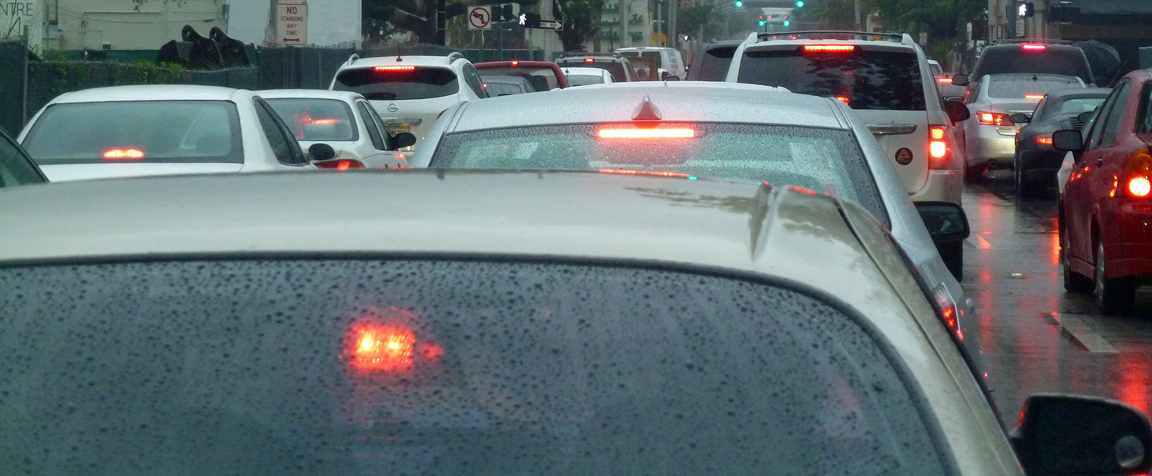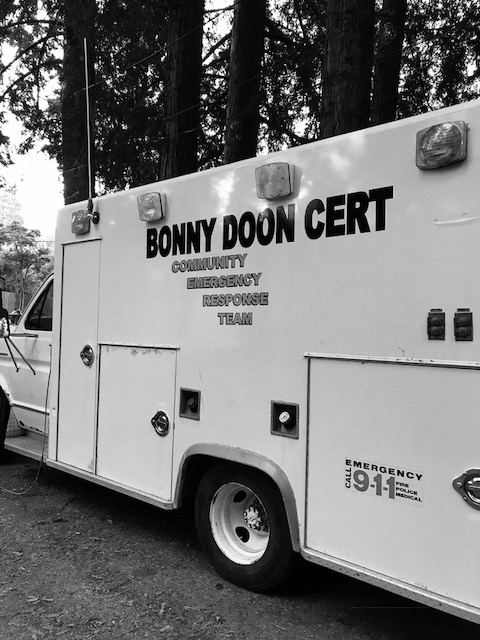 July/August 2018 issue |
|
No July Meeting, as usual, but please join us for the First Annual Taco Social Saturday August 25th at the Martin Road Firehouse See you at the next RBDA meeting Wednesday September 12th 7:30 p.m. Bonny Doon School Multipurpose Room, Pine Flat Road & Ice Cream Grade |
| Santa Cruz Loves “U” On the June 5 ballot, by a greater than 3 to 1 margin, voters said a very loud “No!” to continued UCSC growth by voting “Yes” on U. While the measure didn’t carry any legal weight, since UCs are exempt from local land-use regulations, it did send a strong message to the UC Office of the President and the UC Regents that local residents think the university has outgrown the community’s resources, especially regarding housing, traffic, and water, and has negatively impacted the quality of life in our neighborhoods.  Santa Cruz is now the least affordable place to live in the world, according to a New Zealand study (comparing median income to median house price), and 3rd in the US according to another study. UCSC’s student enrollment is approaching 19,000 (equal to nearly 30% of the city’s population), but nevertheless the university is exploring adding another 10,000 students over the next two decades. The County Board of Supervisors, the Santa Cruz City Council, and now the people of Santa Cruz, have expressed strong opposition to any growth beyond the 19,500 students UCSC is allowed by the year 2020, under the 2008 settlement of lawsuits brought by the County, the City and CLUE (Coalition for Limiting University Expansion), a community group of which the RBDA was a part.  The university is in the early stages of putting together its growth plan for 2020-2040. Unlike in 2004, when UCSC was crafting its 2005-2020 Long Range Development Plan, relations between the city and the university are much more amicable, owing to the lawsuits and the subsequent settlement, which forced the university to actively participate, including financially, in mitigating the impacts of its growth on resources and neighborhoods. This time around UCSC has shown it is willing to hear the concerns of the community, and supply information about how it decides where to grow, and by how much. To this end it formed a Citizens Advisory Group composed of political and community leaders, in which the RBDA is participating. It has become clear that growth targets for the nine UC campuses that serve both undergraduates and graduates are determined largely by financial considerations. When the Regents look at UCSC, rather than seeing a college set in a small town (the smallest of the UC host cities), which values a relatively laid-back lifestyle and natural beauty, and which has limited resources, they see a campus with about 1,500 undeveloped acres, forest and meadows, which can be built on much more cheaply than in cities like Los Angeles, Berkeley or Irvine, as examples. The California legislature has been increasingly stingy with funding higher education. Every year support for the UC system shrinks, as a percentage of each campuses’ budgets. Even though the legislators pay lip service to providing economically disadvantaged students with the opportunity to earn a college degree, they refuse to subsidize student housing. The irony of expanding UCSC enrollment is that they are inserting those students into a highly expensive housing market, and they demand even more money from them (on a per capita basis) to live on campus. One result is that students find it cheaper to live in town than on campus, crowding eight or more in a two -or three-bedroom house, or in a ramshackle, even dangerous apartment built in a garage or backyard, or even in their cars. At the June 28 meeting of the advisory group the community members, including the County supervisors and City council people, and UCSC Chancellor George Blumenthal responded enthusiastically to a suggestion from John Aird of the Coalition for Limiting University Expansion (CLUE) that we all work together, and with other UC campuses and host cities, to pressure the state legislature to devote more money to public higher education. In the latest State budget, less than 2% is earmarked for the UC system and 2% for the CSUs. How can the UC decision makers be persuaded that Santa Cruz can’t, and doesn’t want to, accommodate a campus of 28,000 students, plus the increased number of professors, staff and their families? It started with the overwhelming support for Measure U. Now our elected representatives must step up, including lobbying the legislature and martialing support among various constituencies. One such is the families of students, who have been suffering from a decline in the quality of education due to the State’s shrinking support. The ratio of professors to students continues to go down, meaning larger classes or even having to graduate later because they can’t enroll in required courses. Of course, this makes their education more expensive. (It wasn’t too long ago that tuition was free; now it’s around $14,000 a year). With room and board and various fees the total annual cost for in-state students is about $36,000. For a $14,000 room and board charge students are shoehorned into dorm rooms meant for fewer occupants, and even student lounges. Classrooms and libraries are jammed. UCSC has fallen to 7th of the nine UC campuses, according to the US News and World Report rankings, and is number 33 in its national “Top Public Schools.” UCSC is scheduled to issue the first draft of its 2020-2040 long-range plan next spring. (Originally targeted for fall 2018; apparently negative public reaction to the growth target is having an effect.) Once the final plan is adopted, UCSC will study the potential impacts to the community’s resources and the environment in an Environmental Impact Report (EIR). At that time the public will be able to comment, and it will undergo a final revision for adoption by the Regents. (Under the law, the UC system reviews and approves its own EIRs.) Then, perhaps, like in 1988 and 2005, there will be lawsuits. UCSC seems very anxious to avoid another expensive legal battle, one that once again they might not be entirely successful in defending. The key question, “Are they so anxious that they are willing to bend to the concerns of the community?” Support the BD Volunteer Fire and Rescue Team at the First Annual Taco Social  The first annual
Taco Social, is being held on Saturday, August 25,
at the Martin Fire Station at 975 Martin Road. This will
be the primary fund raiser for the Bonny Doon Fire and
Rescue Team this year. It is bound to be an informative
event for the community as well as a lot of fun for the
entire family. The first annual
Taco Social, is being held on Saturday, August 25,
at the Martin Fire Station at 975 Martin Road. This will
be the primary fund raiser for the Bonny Doon Fire and
Rescue Team this year. It is bound to be an informative
event for the community as well as a lot of fun for the
entire family.The Bonny Doon organizations that are sponsoring the event include the Bonny Doon Fire and Rescue Team, the Bonny Doon Community Emergency Response Team (CERT), the Bonny Doon Fire Safe Council, Friends of the Bonny Doon Ecological Reserve, Local Bonny Doon Ham Radio operators and the Rural Bonny Doon Association. Each of the organizations will have an information booth to share info on how to prepare for (or avoid) a disaster. In addition, CalFIRE, PG&E, and Animal Rescue folks will also be on hand to provide useful information on what to do in the event of an emergency, and how you can prepare yourselves and your family and pets. In addition to delicious $5 tacos and associated refreshments, there will be live music provided by great local musicians Charlie and Jessica, Bob Peters, and Andy Fuhrman, and activities for the kids, including a bounce house. This gala event will be held from 2 to 7 PM, and we hope to see you there! We are also looking for volunteers. Tasks include helping to set up on Friday, assisting at the event itself on Saturday, and final cleanup tasks on Sunday If you have questions or would like to volunteer, please contact BonnyDoonCERT@gmail.com. Your County Budget  By Ryan Coonerty, Third District Supervisor. On June 26 the Board of Supervisors approved Santa Cruz County’s 2018-2019 budget. Passing a balanced budget and setting our spending priorities is the most important action the Board takes all year. My goal, as always, is to allocate the County’s funding to reflect the priorities and values of Santa Cruz County residents. I’m happy to report that the County is demonstrating good fiscal stewardship. We have increased reserves and improved the county’s credit rating, saving taxpayers millions in interest payments. We’ve reduced pension obligations, controlled employee growth, and made some in-roads on deferred maintenance. We’ve also invested in critical services. Through programs such as the Nurse-Family Partnership, Thrive by Three and Drug Medi-Cal expansion (which doubles access to substance abuse treatment) we are working to improve community health. We are responding to the homelessness epidemic by working with our partners to expand effective services to decrease homelessness. At my urging, the County established a Homeward Bound fund, which provides a bus ticket for homeless individuals to return to their home community where they have support networks. We are also expanding the Downtown Streets Team, which provides homeless individuals with work experience and training while doing street, beach, and park clean-ups. In this year’s budget, we are expanding this program and creating a team dedicated to cleaning the North Coast beaches and roadways. We anticipate that the new Downtown Streets Team will be out on the North Coast by mid-July. During budget hearings, we also identified a number of unmet needs and challenges such as addressing the behavior of treatment-resistant individuals who negatively impact our community, enhancing our parks, and improving our roads. I’m working with other Boardmembers, staff and community partners to effectively address these unmet needs and I’ll have more information on new approaches to share with you soon. I encourage you to take a look at the budget online, there is user-friendly information that provides an overview of County government and finances as well as statistics and demographics of the County (www.santacruzcounty.us). As always, please feel free to contact my office at 454-2200 with questions about the budget or any other issue. San Vicente Redwoods Parking Lot Construction Begins in Spring 2019  The Land Trust
of Santa Cruz County (LTSCC) recently released their
public access plan for San Vicente Redwoods (SVR), and
hosted a series of informational public meetings at
Bonny Doon Elementary, as well as neighborhood meetings
to discuss the implementation and impact of their plans. The Land Trust
of Santa Cruz County (LTSCC) recently released their
public access plan for San Vicente Redwoods (SVR), and
hosted a series of informational public meetings at
Bonny Doon Elementary, as well as neighborhood meetings
to discuss the implementation and impact of their plans.
SVR is an approximately 8,500-acre property located between Davenport and Bonny Doon that was purchased in 2011 by the Peninsula Open Space Trust, Sempervirens Fund, and Save the Redwoods League, and the LTSCC. Their vision was to ultimately protect this property for future generations while allowing sustainable land use and activities, including recreation, and research/education alongside preservation, restoration and timber harvesting. As we discussed in the May edition of The Highlander, the LTSCC public access plan employs an adaptive management approach, where access to the property will occur in three phases. Advancement from phase to phase is reliant on successful management using multiple metrics which include: no development of unauthorized trails, maintaining trails and signage, keeping trails free of food waste, dog waste, and horse waste, keeping parking from spilling out onto Empire Grade and surrounding properties, and visitor satisfaction. Securing necessary funding to manage, patrol and maintain the property is also required to advance phases. LTSCC will be instituting a permit system and register all users to incentivize responsible use of the property and as a way of communicating with users about trail closures, misuse, etc. They will be partnering with the County Sheriff’s Office, CalFIRE and County Parks for law enforcement, emergency response, and stewardship. For details on the Public Access Plan, the LTSCC planning document is available at landtrustsantacruz.org/svr_publicaccessplan_publicreview-/. For the Upper Empire Grade and Braemoor communities, one of the chief concerns is parking and staging on private residential roads. There is only one currently planned access to the property, which will be across from Crest Ranch on Empire Grade, about a quarter-mile past Braemoor Drive. Bryan Largay of the LTSCC held several neighborhood meetings for residents in the vicinity of the future parking lot in May, and led a walk down to the planned site of the parking lot. Largay discussed with community members why this site was chosen from the several that were considered, which included minimizing proximity to residences, not interfering with activities on Warrenella Road, distance from the correctional facility, as well as safe access to trailheads. The parking lot will be constructed about 100 meters off Empire Grade, down a small embankment, keeping the lot out of site and protecting residents from vehicle noise. The parking lot will be opened as part of Phase I with a capacity of 25 to 40 cars, but will be permitted for about twice as many cars, so that expansion of the parking lot can proceed rapidly if LTSCC has underestimated the property usage. The parking lot is anticipated to have a kiosk and bathrooms and will be secured at night. There will be no allowed overnight use of the property. The LTSCC is willing to take additional measures to ensure that people do not park illegally to use the property, such as posting “No parking” signs along Empire Grade, if warranted (and requested) after the property opens, reinforcing the fencing bounding the property where illegal entries are occurring, etc. The LTSCC public access plan has been shaped in part by engaging with the community, according to Largay, and the LTSCC has thought of how to respond to many contingencies. Construction of trails is anticipated to begin in the spring of 2019, opening Phase I access by the end of 2019. Do you have any concerns about the LTSCC’s management plan for SVR? What do Braemoorians and Upper Empire residents consider an unacceptable impact to their neighborhood? Shutting Down the Grid to Prevent Wildfires?  During
the County Board of Supervisor meeting on June 26,
representatives from PG&E made a presentation about
the implementation of their Community Wildfire and
Safety Program plan, and the implications for Santa Cruz
County (Regular Agenda Item #84). As we all know, years
of drought, extreme heat and diseased/dead trees have
exacerbated the risk of wildfires in the Santa
Cruz Mountains. PG&E’s Community Wildfire and Safety
Program aims to improve preventative measures to avoid
devastating wildfires. This is a critical effort;
however, one facet of their plan may have a great impact
on Bonny Doon residents. PG&E plans to temporarily
de-energize power lines during conditions where
high-risk fire conditions have been predicted. During
the County Board of Supervisor meeting on June 26,
representatives from PG&E made a presentation about
the implementation of their Community Wildfire and
Safety Program plan, and the implications for Santa Cruz
County (Regular Agenda Item #84). As we all know, years
of drought, extreme heat and diseased/dead trees have
exacerbated the risk of wildfires in the Santa
Cruz Mountains. PG&E’s Community Wildfire and Safety
Program aims to improve preventative measures to avoid
devastating wildfires. This is a critical effort;
however, one facet of their plan may have a great impact
on Bonny Doon residents. PG&E plans to temporarily
de-energize power lines during conditions where
high-risk fire conditions have been predicted.During high-risk periods, PG&E plans to send out responders to Tier 3 high-risk areas of the County (almost all of Bonny Doon has been classified as “Tier 3 Extreme” by the California Public Utilities Commission) to make the decision whether or not to de-energize power distribution lines. Affected customers should be notified in three stages: 48 hours in advance, 24 hours in advance and once the power has been shut off “when and where possible.” Once distribution lines are de-energized, it can take as much as 2-5 days for them to be re-energized. PG&E plans to establish “micro-grids” with shelters for those who must have electricity for medical equipment. These centers will be run by local churches and community groups but we need to press PG&E for more information on how this will be implemented. PG&E is advising customers in high fire-threat areas to plan for this to happen “1-2 times a year during wildfire season.” Details of their plan and further information about how you may be impacted can be found at www.pgecommitment.com/community-wildfire-safety-program. The implementation of this approach may have heavy impacts in our community. Many of us are on wells, and without electricity we will be without water, making it difficult to stay in our homes, or soak roofs and areas surrounding our homes. Furthermore, this may pose a public safety risk if we are unable to communicate; many people no longer have traditional copper wire phone lines, and without power VOIP and WiFi based communications will not work. Additional preventative measures, anticipated to cost PG&E $15 billion, will include aggressive tree clearing along distribution lines as well as replacing wooden utility poles with non-wood poles, increasing space between wires, and replacing wires with insulated wires less prone to arc.  Ed: [Bonny Doon has been through this before—see these old pages from 1999 and 2000: pg&e_index.html] During the meeting, Board members vocalized their concern about PG&E’s lack of public outreach as well as their disregard for going through the California Environmental Quality Act (CEQA) process. They enacted a motion to ask County Counsel to write a letter regarding these issues to PG&E and CPUC and to review whether the plan adhered to CEQA and Santa Cruz County Codes. The Board also requested that PG&E organize community meetings, especially in rural neighborhoods. Do you have concerns about PG&E’s approach? How will you be impacted by the loss of power intermittently during wildfire season? We’d like to hear from you – contact us at board@rbda.us. We also urge you to contact Supervisor Ryan Coonerty (831-454-2200, Ryan.Coonerty@santacruzcounty.us) or PG&E (866-743-6589) with your questions and/or concerns. Thanks to Debbie Hencke for reporting a lot of the information in this story.  Power Switch As of July 1, unless you opted out, you are now the customer of Monterey Bay Community Power, owned by the three counties which formed it—Santa Cruz, Monterey and San Benito— instead of PG&E. MBPC will buy the power, but PG&E will continue to handle billing, power transmission and power grid maintenance. MBCP says it offers three key benefits: “reduction in greenhouse gas emissions, lower cost to customers and investment in our local community. MBCP’s default power portfolio, MBchoice, is carbon-free, sourced from renewable sources such as solar, wind, and carbon free sources such as hydroelectric generation. MBCP will not procure power from nuclear or fossil-based sources. MBCP’s electric generation rates will match PG&E’s, and will be inclusive of costs related to PG&E’s exit fees. Customer cost savings will result from a minimum 3% rebate in 2018 for all customers.” For more info, go to www.mbcommunitypower.org. |
First Annual Taco Social - The
Prequel: |
Speaking of CERT, are you ready for the NEXT BIG ONE...?  The next big disaster, that is. The Bonny Doon Community Emergency Response Team (CERT) offers training to community members to help them prepare for disasters. As we all know from this year’s winter storms, our rural community can become isolated for hours or even days if a large-scale event impacts our area. CERT training teaches basic preparedness, fire safety and utility control, basic disaster medical operations, light search and rescue and disaster psychology, among other important skills. CERT members learn how to prepare themselves, their families and their loved ones for events where emergency service personnel are initially overwhelmed and we need to take care of ourselves and our neighbors until professional help arrives. After taking Basic Training, Bonny Doon’s CERT offers additional opportunities for more advanced training, such as First Aid and CPR, obtaining a “Ham Radio” license for emergency communications, classes in Search and Rescue, workshops to teach us how to work with the Red Cross to set up temporary shelters, Traffic Control, and classes in the Incident Command System, which is used by all emergency responders to manage disasters. Inquire. BonnyDoonCERT@gmail.com |
 |
 Are you an RBDA Member? Join the conversation, get news updates on the Facebook page exclusively for RBDA members: RBDA, Rural Bonny Doon Association |
|
Support Our Sponsors! Frans Lanting Gallery
Become
One of Our Sponsors
|
|
The
Highlander Bonny Doon's voice
in preserving our special quality of life, Send mail
correspondence to the Highlander Editor at the above
address, Support the RBDA - Renew Your Membership: all 1-year memberships expire on January 31st. Your continued support enables the RBDA Board to work on issues critical to Bonny Doon, to hold meetings to educate and get feedback regarding those issues, and to publish The Highlander newsletter. Some people may not understand that receiving The Highlander in the mail doesn’t mean you are a current RBDA member. To reach the whole community we mail The Highlander to all mailboxes in Bonny Doon. So unless you joined for multiple years, all 1-year RBDA memberships will expire on Jan. 31, 2016. To continue to support the RBDA, we need you to renew now for the 2016 year. Details are here. Dues and donations go mainly to printing and mailing The Highlander, and rent and insurance for the public meetings at the school. |
|
Ideas
for RBDA Meeting Topics? We are always open to
suggestions for interesting programs and speakers at
our bimonthly (except July) RBDA public meetings.
What are
you interested in? Local flora and fauna, gardening,
environmental and political issues, Bonny Doon history
or geology, public safety?
What were
some of your favorite speakers or presentations at
past RBDA meetings? Were
there any that you would like us to repeat?
Please email us with your ideas and
comments at board@rbda.us. |
|
The Bonny Doon Planning District  If you
live in or own property within this district, roughly
from Empire Grade to the ocean Please support the RBDA!
Annual dues are used primarily for printing and mailing The Highlander, your voice for keeping Bonny Doon rural and natural. Click here for details! Those who make additional contributions qualify as: CONTRIBUTORS ($ 25+ dues) SUSTAINERS ($50+ dues), or PATRONS ($ 100+ dues)
|